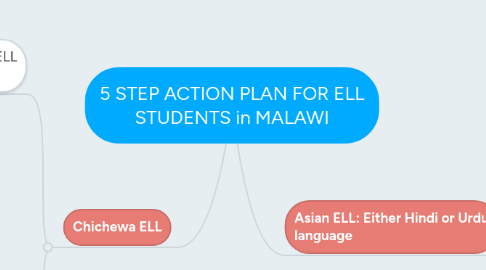
1. Chichewa ELL
1.1. Increase confidence on Chichewa ELL on their English Speaking abilities.
1.1.1. WHO: Teachers will promote ELL confidence on their speaking abilities
1.1.2. WHAT: In small groups, students will work collaboratively to put together a role play
1.1.3. WHERE: At the classroom setting
1.1.4. WHEN: After having a classroom session on writing a skit for a role-play
1.1.5. WHY: Through out small groups, regular students will be encourage to share their knowledge to ELL students. Through kurt a skit, ELL students will have an opportunity to practice their vocabulary, sentence structure and fluency.
1.1.6. HOW: After the role-play teacher will offer positive feedback and praise to all students, especially to ELL students.
1.2. Embrace Chichewa culture in the classroom to promote awareness, mutual understanding and collaboration
1.2.1. WHO: Teachers will promote and display both, English and Chichewa, commonly used phrases and vocabulary relevant to the subject as visual aids.
1.2.2. WHAT: Teacher with the help of ELL and regular students will select phrases and vocabulary that are culturally relevant to students to include them as visual aids in the classroom.
1.2.3. WHERE: In the classroom setting
1.2.4. WHEN: Whenever it is possible and depending on the content of the subjects.
1.2.5. WHY: ELL students will have the opportunity to share cultural background and norms to the class. Regular students will have the opportunity to explore and appreciate cultural differences while promoting mutual understanding and respect.
1.2.6. HOW: After students have selected content for visual aids, teacher will display them accordingly around the classroom. If time allow, students can help display the visual aids.
2. Asian ELL: Either Hindi or Urdu language
2.1. Promote parental outreach and understanding of classroom expectations and learning techniques
2.1.1. WHO: Teachers will lead workshops with all parents to promote understanding of classroom expectations while promoting collaboration, mutual respect, understanding and appreciation of cultural differences.
2.1.2. WHAT: As part of the workshop parents can reflect on cultural differences and appreciation to promote mutual respect.
2.1.3. WHERE: In the classroom
2.1.4. WHEN: At the beginning of the school year
2.1.5. WHY: Teachers and parents will explore cultural differences related to learning expectations. It is important for teachers and parents to understand each other learning goals.
2.1.6. HOW: After a brief introduction and discussion, teacher can share goals and rubrics with parents for units or subjects. Teacher can form small groups with guided questions that facilitate parents brainstorming of related topics.
2.2. Promote students' collaboration, trust and team building
2.2.1. WHO: Teacher will plan activities where each student has specific roles to complete a task.
2.2.2. WHAT: After forming small groups, students will be assigned to different activities according to their skills and interest.
2.2.3. WHERE: At the classroom or if possible during a field trip
2.2.4. WHEN: Through out the school year
2.2.5. WHY: ELL students will benefit from actively participating in an activity where they can demonstrate a strong skill. Regular students will learn to rely on ELL students to complete a task.
2.2.6. HOW: At the end of the exercise, teacher will reflect on the importance of working together towards completing a task. Teacher will use this reflection to create a lessons learn visual aid to include in the classroom as visual aid.
